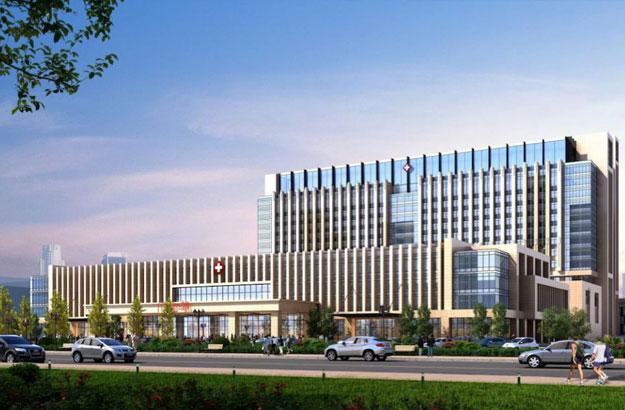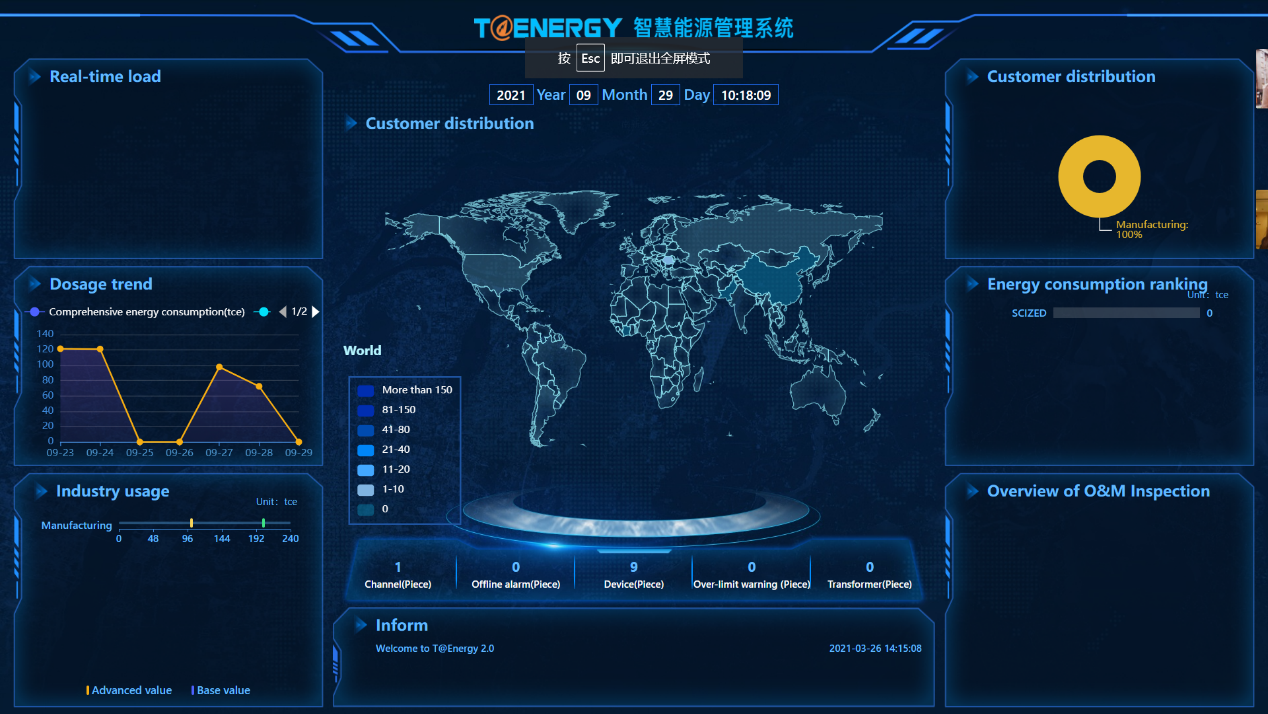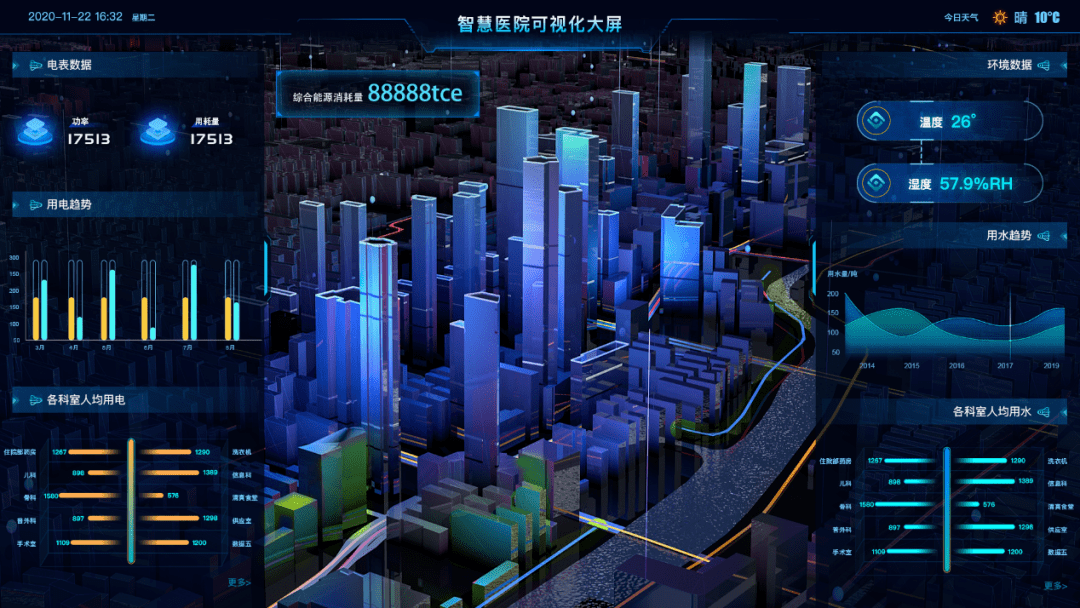Hospital Smart Energy Management System
The hospital smart energy management system can optimize the hospital energy structure, reduce energy consumption, improve energy efficiency, and then improve the level of hospital energy management. It can help to solve the energy supply tensions, energy costs increasing problems and strengthen energy security, improve the medical environment, and promote the growth of hospital profits while reducing energy costs.

I. Current status of hospital energy management
1. Low degree of informationization
In recent years, hospital informatization construction, especially the treatment informatization construction, has developed rapidly, but the information construction of logistics operation and security system is relatively lagging behind. As an important part of logistics support work, the comprehensive management of stock energy is difficult to match the speed of the rapidly developing informationization of treatment.
2. Large area, many dead ends
One of our cases, the hospital currently has 18 buildings (clusters) of various types formed over the years in the old and new hospital areas, and although more than 70 logistics staff work hard, it is difficult to conduct comprehensive inspections, and there are some management dead ends, as well as energy waste such as excess supply of air conditioners and unbalanced energy use.
3. More electricity, less protection
Nowadays, the national grid is generally only responsible for the part outside the property rights demarcation point (transformer) of the electricity-using unit. The low-voltage side part, such as distribution facilities, electrical equipment, cable circuits, etc. are responsible by the hospital management team. There still exists the lack of effective monitoring, warning and emergency linkage of the hospital's low-voltage side power quality.
4. There are standards, but it is difficult to assess
Hospitals have built energy management systems, but the lack of objective assessment indicators, assessment is difficult to quantify, energy saving and energy management systems are often formal or disconnected from the actual situation.
So in response to the above difficulties in hospitals, Compere has launched a hospital intelligent energy management system, which is a good solution to the difficulties encountered by hospitals. The following is a brief introduction of the energy management system.

2.1 Energy management system function
Smart hospital energy management system combines the medical industry's "Internet + medical" model, fully combines the competent medical and health departments and the Ministry of Housing and Construction on green hospital energy standards, hospital user needs and energy management department requirements, collects and analyzes energy, energy consumption, energy efficiency data, monitors power quality, electricity safety-related indicators other energy use indicators, and organically integrates with national energy policies and energy use model reform. The intelligent hospital energy management system currently includes an energy consumption management subsystem, a safe electricity consumption management subsystem, and several subsystems related to hospital energy, energy consumption, and energy efficiency.
2.1.1 Energy consumption management sub-system
Through energy classification and sub-metering and smart port application, this system can realize below functions:
(1) Analyze hospital energy structure and energy bill according to classification and itemization.
(2) Through real-time monitoring, trend tracking and comparison of classified and itemized energy consumption, summarize hospital energy consumption rules, provide a basis for energy load staggering management, shorten the time for abnormal energy consumption discovery, positioning and processing, and reduce energy waste.
(3) Safe electricity management sub-system
This system provides power quality, safety warning and emergency linkage functions, improves power management, promotes hospitals to take effective measures to improve power quality, investigate power safety hazards, and reduce or even eliminate equipment efficiency and life span reducing and electrical fire accidents caused by power quality and safety hazards.

(4) Central air conditioning management subsystem
Through intelligent transformation of the central air conditioning system, the optimal cooling and heating production and supply strategy is calculated by fuzzy algorithm based on key factors such as indoor and outdoor temperature, multi tariff electricity price, equipment operation efficiency and water supply and return temperature, etc., supply cooling on demand and improve the comprehensive energy saving rate.
2.2 Analysis of energy management system applications
2.2.1 The basis of energy saving and efficiency enhancement
Through the analysis of big data, we can discover abnormal energy use, low energy use, energy loss, energy waste and other aspects of the hospital, and form targeted energy-saving rectification suggestions to achieve the effect of improving energy efficiency, energy conservation and emission reduction.
2.2.2 Safe electricity consumption
Timely detection of power quality and safety hazards such as over-voltage, over-load, harmonics, phase loss, leakage, three-phase unbalance, high line temperature and low power factor, etc., and timely warning to provide a quality and safe power environment for the hospital.
The construction of energy management system, comprehensive energy supply and energy-saving transformation, and safe electricity service provide new ideas of hospital logistics management under modern energy integration service mode. And on the basis of energy IOT construction, the development of hospital building networking and equipment IOT construction, the unified management of hospital resource management system of all kinds of infrastructure and its spatial data, attribute data and business data, the realization of BIM-based asset and equipment operation and maintenance whole life cycle management, so that operation and maintenance management is more timely, effective, intuitive and intelligent, providing a reliable basis for hospital resource planning and scientific scheduling.


